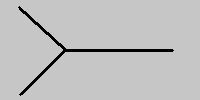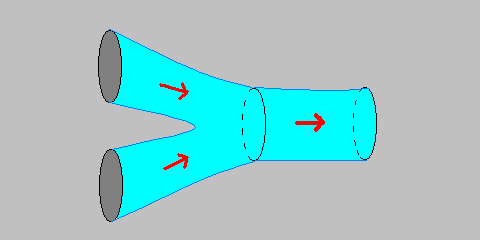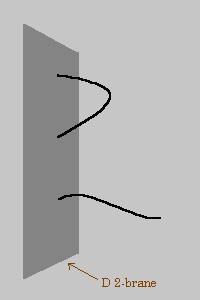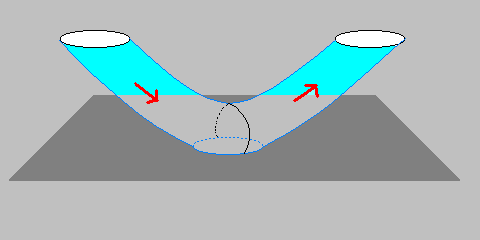
One of the greatest problems in modern physics has been unifying gravity with the other forces. This has finally been achieved using string theory. Traditionally, fundamental particles such as electrons were thought of as point-like 0-dimensional objects. A generalization of this is fundamental strings, which are 1-dimensional objects. They have no thickness but do have a length, typically 10-33 cm.This is very small compared to the length scales that we can reasonably measure, so these strings are so small that they practically look like point particles. However, their stringy nature has important implications.
Strings can be open or closed. An open string is a line segment, and a closed string is a little loop. As they move through space-time, they sweep out an imaginary surfacecalled a worldsheet. An open string will sweep out a 2-D strip, and a closed string will sweep out a hollow tube.
Strings have certain vibrational modes which can be characterized by various quantum numbers such as mass, spin, etc. The basic idea is that each mode carries a set of quantum numbers that correspond to a distinct type of fundamental particle. This is the ultimate unification: all the fundamental particles we know can be described by one object, a string! A very loose analogy can be made with, say, a violin string. The vibrational modes are like the harmonics or notes of the violin string, and each type of particle corresponds to one of these notes.
Let's say you had a closed string with the following mode:

This is a mode that is characteristic of a spin-2 massless graviton, the particle that mediates the force of gravity. This is one of the most attractive features of string theory. It naturally and inevitably includes gravity as one of the fundamental interactions.
Let's say you had the following Feynman diagram:

In string theory, it would be described like this:

The fact that there are no sharp edges or vertices in the string version is what makes it possible to combine gravity with the other forces. When you combine string theory with supersymmetry, you have superstring theory.
Strings interact by splitting and joining. The above example is the annihilation of two closed strings into a single closed string. Notice that the worldsheet of the interaction is a smooth surface. This essentially accounts for another nice property of string theory. It is not plagued by infinities in the way that point particle quantum field theories are. Notice that the interaction point occurs at a topological singularity in the Feynman diagram.
If you glue two of the basic closed string interactions together, you get a process by which two closed strings interact by joining into an intermediate closed string, which splits apart into two closed strings again. This is the leading contribution to this process and is called a tree level interaction. To compute quantum mechanical amplitudes using perturbation theory, we add contributions from higher-order quantum processes. Perturbation theory provides good answers as long as the contributions get smaller and smaller as we go to higher and higher orders. Then we only need to compute the first few diagrams to get accurate results. In string theory, higher-order diagrams correspond to the number of holes or handles in the world sheet.
This is a great improvement, since at each order in perturbation theory there is only one diagram. In point particle field theories, the number of diagrams grows exponentially at higher orders. Unfortunately, extracting answers from diagrams with more than about two handles is very difficult due to the complexity of the mathematics involved in dealing with these surfaces. Perturbation theory is a very useful tool for studying the physics at weak coupling, and most of our current understanding of particle physics and string theory is based on it. However, it is far from complete. The answers to many of the deepest questions will only be found once we have a complete non-perturbative description of the theory.
Historically, strings were introduced to describe the world of hadrons; but the appearance of spin 2 particles in the string spectrum, as well as other problems, prompted J. Scherk and John Schwarz to suggest that they may be relevant for the description of a unified theory of gravity and elementary particles. It is this idea which has been developed into the beautiful superstring theories, which some believe could represent the ultimate theory of everything.
The fundamental objects in superstring theories are one-dimensional strings rather than zero-dimensional points; and when they evolve they sweep out two-dimensional surfaces. It is amazing that a supersymmetric version of these strings leads to many important ingredients, such as the gauge groups, the fermion representations, etc., that form the core of the unified gauge theories. At the same time, it fixes the number of space-time dimensions. There are also strong hints that these theories are free of the divergence difficulties that exist with local field theories.
Let's say you have a bosonic string, which is given by the variable x([sigma], [tau]) where [sigma] parametizes the position of a point on the string and [tau] gives the time evolution. The variable x([sigma], [tau]), then, describes a surface embedded in the d-dimensional space-time, where u = 0,1,...d-1, and u is the dimension of x.
To describe the quantum mechanics of this system, you need an action which we will write down in analogy with the case of point particles. The action of the point particle is given by the distance on the world line. Using this analogy, Nambu and Goto postulated that the action of a string must be given by the area of the surface swept by the string. To calculate the area, you look at a blown-up version of an infinitesimal area on the world surface of the string. The area enclosed by ABCD is given in Minkowski space as
[delta]A = (dx/d[sigma])(dx/d[tau]) d[sigma]d[tau] sinh [theta]
[delta]A = (dx/d[sigma])(dx/d[tau]) d[sigma]d[tau]((cosh2)[theta] -1)(1/2)
[delta]A = d[theta]d[tau]{(x' x")2 - x'2 x"2}(1/2)
where x' x" = x'u x"u, x'2 = x'u x'u, x'u = dxu, x" = dxu/d[tau]. I'm using " for differentiation with respect to time. The action for the string is then given by
L = T[integral]d[sigma]d[tau] {(x' x")2 - x'2 x"2}(1/2)
where T is the string tension which has a mass dimension 2.
Notice an important symmetry group for the string, which is invariance under the reparametization, or coordinate transformation, of [sigma], [tau]< to [sigma]', [tau]'.
In the first superstring revolution (1984-1985), we learned there were five consistent superstring theories: I, IIA, IIB, HO, HE each of which requires 10 dimensions, with 9 space and one time. The extra six dimensions must curl up into a tiny geometrical space. Since space-time geometry is determined dynamically (as in General Relativity), only geometries that satisfy the equations are possible. The HE superstring theory on a particular kind of six-dimensional space, a Calabi-Yau space, resembles the Standard Model of particle physics at low energies.
Type IIA and IIB are superstring theories, which means they combine supersymmetry with string theory. The excitations on a string can be thought of as little waves that travel around a string. HO and HE string theory are heterotic string theories, which means the waves traveling one direction are supersymmetric, and those traveling in the other direction are not. Here is a brief description of the string theories.
Type I - can be open or closed, has SO(32) gauge symmetry, and is parity violating
Type IIA - closed, has no gauge symmetry, and is parity conserving
Type IIB - closed, has no gauge symmetry, and is parity violating
HO - closed, has SO(32) gauge symmetry, and is parity violating
HE - closed, has E(8) x e(8) gauge symmetry, and is parity violating
Recently, it was realized that these five different versions are simply different mathematical formulations of a single underlying theory called M-theory. It's similar to how in quantum mechanics, Heisenberg's matrix theory and Schrodinger's wave theory are mathematically equivalent, and are simply different formulations of a single underlying theory.
It is often said that superstring theory is not testable because string phenomena exist at such short distances and such high energies. We will probably never be able to do experiments at 1019 GeV or at 10-33 cm. As a result, several people, including great physicists such as Sheldon Glashow, have claimed that string theories are not testable, which, in turn, led John Horgan to write a book titled The End of Science. However, this is not true. The theory of superstrings is testable.
First of all, a theory that can explain why we observe three families of chiral quarks and leptons will have passed a big test. It must also explain why matter comes as quarks and leptons but not other possible forms such as leptoquarks. If superstrings can do that, that's strong evidence in its favor. Second of all, experimental evidence doesn't have to come out of a massive supercollider. There are ingenious ways of looking at low energy phenomena and finding evidence either for or against superstrings. Some superstring models determine the electron, muon, tau, and quark masses. Calculating the ratio of tau to muon masses correctly will be a convincing test. The rotation from symmetry eigenstates to mass eigenstates, and the associated CP violation phase, will have to emerge from a successful model.
Whether the proton can decay, the associated lifetime, and final states may probe distances near the Planck scale. Due to the way the observed gauge groups break, there may be extra U(1) symmetries that lead to one or more Z' bosons. The presence or absence of these bosons and their properties would be a major test of the theory. If superstring theories can explain why the neutrino mass is so small and predict or explain the present and future observed neutrino data, that will be a major test.
Basically, if a superstring theory can predict or explain what we observe about particle physics, that will be strong evidence in its favor. It is not necessary to build a supercollider that can actually reach the stupendous energies at which stringy phenomena would become readily observable.
Strings can have various kinds of boundary conditions. For example, closed strings have periodic boundary conditions (the string comes back onto itself). Open strings can have two different kinds of boundary conditions called Neumann and Dirichlet boundary conditions. With Neumann boundary conditions the endpoint is free to move about but no momentum flows out. With Dirichlet boundary conditions the endpoint is fixed to move only on some manifold. This manifold is called a D-brane or Dp-brane (p is an integer which is the number of spatial dimensions of the manifold). Here, open strings with one or both endpoints are fixed on a two-dimensional D-brane or D2-brane.

D-branes can have dimensions ranging from -1 to the number of spatial dimensions in our space-time. Superstrings exist in a 10-dimensional space-time which has 9 spatial dimensions and one time dimension. Therefore, the D9-brane is the upper limit in superstring theory. Notice that in this case the endpoints are fixed on a manifold that fills all of space, so it is really free to move anywhere and this is just a Neumann boundary condition. The case p= -1 is when all the space and time coordinates are fixed; this is called an instanton or D-instanton. When p=0 all the spatial coordinates are fixed so the endpoint must live at a single point in space; therefore, the D0-brane is also called a D particle. Similarly, the D1-brane is also called a D-string. The suffix "brane" comes from the word "membrane." The full word "membrane" is reserved for 2-dimensional manifolds or 2-branes.
D-branes are actually dynamical objects which have fluctuations and can move around. For example, they interact with gravity. Here you see one way in which a closed string representing a graviton can interact with a D2-brane. Note how the closed string becomes an open string with endpoints on the D-brane at the intermediate point in the interaction.

Branes have been tossed around by theorists since the mid-1980's. What we normally think of as a membrane, something like a thin elastic sheet, is called a 2-brane, the 2 standing for the number of dimensions of the sheet. A string could be called a 1-brane, a membrane with one dimension. A similar elastic object of three dimensions would be a 3-brane. In p-dimensional space, you could have a p-brane. A conventional point particle is a 0-brane.
As originally conceived, a theory of fundamental two-dimensional membranes seemed a natural extension of string theory; but in many respects such models appeared much less tractable than models of strings or conventional point particles. D-branes, however, arise in a different manner as entities whose presence in the full nonperturbative theory is implied by a type of symmetry. A D-brane can be viewed as a kind of topological defect that has the distinguishing property that string endpoints get stuck on it and all the dynamics of the object comes from these stuck strings.
Joseph Polchinski, working with Jin Dai and Robert Leigh at the University of Texas in Austin, thought up D-branes in 1989 while working to better understand the behavior of strings when some space dimension is shrunk down to a circle of radius R. For closed strings, strings that form closed loops with no endpoints, there was a well-defined correspondence between one theory with very small R, and another with a large R' = [alpha]'/R, where [alpha]' is approximately the square of the Planck length. Today, this relation is better understood in terms of T duality. It was not clear how closed-string duality could coexist with open strings which have two endpoints. Polchinski, Dai, and Leigh solved this puzzle when they realized that the ends of the open strings had to be attached to an extended object, which turned out to be the D-brane.
Consider what duality does to the boundary conditions at the ends of open strings. For a free open string, before the duality transformation is carried out, Neumann conditions apply at each end of the string. No current or energy flows off the ends. However, after the duality transformation is applied, the ends of the dual open strings are all restricted to lying within a single hyperplane with the dimensions of the hyperplane dependent on how many dimensions of space-time are dualized. This restriction on the location of the string ends is a set of Dirichlet conditions, and the hyperplane is a prototypical Dirichlet-brane, or D-brane. When you allow for the effects of virtual open strings interacting with a D-brane, you see that it is not rigid and fixed in space but is a dynamical entity with an effective action. It can oscillate, move through space-time, and interact with strings and other D-branes.
In late 1995, Polchinski demonstrated that D-branes carry charges analogous to an electric charge. This crucial development enabled Andrew Strominger and Cumrun Vafa to construct charged quantum black-hole states out of a combination of strings and D-branes and then count the number of quantum states present. Also, the specific spectrum of charges carried by D-branes neatly fills out multiplets of states that you would expect to be present because of the duality symmetry of string theory.
The success of D-branes has led people to address the question of what D-branes and strings are at a more fundamental level. One possibility is that strings could be made of D-branes. Tom Banks, Stephen H. Shenker from Rutgers University, WillyFischler of the University of Texas at Austin, and Leonard Susskind of Stanford, put forward a proposal that realizes this possibility. In this proposal, the fundamental objects are 0-branes, described by supersymmetric matrices. The matrix model is one proposal for what theorists call M-theory, an 11-dimensional theory to which all the flavors of superstring theory seem to be related. Superstring theory is usually formulated in 10 dimensions. Theorists in this field are currently devoting much of their activity to testing the matrix model proposal.
Other possibilities of what D-branes and superstrings may be at a more fundamental level are that D-branes and strings could both be fundamental, that D-branes could be solitons made up of strings, or that D-branes and strings could be made of something else altogether.
A recent theory is brane world cosmology, which states that the Universe itself is a giant D-brane. This explains the hierarchy problem, and is derived from Kaluza-Klein theory which was developed at the very beginning of the 20th Century. For more on brane world cosmology, read my paper on the subject on my homepage.
http://www.geocities.com/jefferywinkler
I hope you enjoyed this glimpse of the Universe at modern fundamental level. Of course, the story isn't over, and will never be over. There will always be unanswered questions, and will always be physicists trying to answer them.